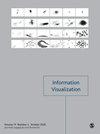分层多元数据的可视化:仇恨言论的分类和案例研究
IF 1.8
4区 计算机科学
Q3 COMPUTER SCIENCE, SOFTWARE ENGINEERING
引用次数: 2
摘要
多变量分层数据在许多应用中起着重要的作用。找到最适合具体数据的最佳可视化对于探索和理解数据之间的关系至关重要。本文提出了一种基于层次数据内部形状(即内部节点的连通性程度、节点的数量等)的分层数据分类方法——伸长和紧凑(Elongated and Compact)。基于这种分类法,我们探索隐式和显式布局——树状布局、圆形布局、力布局和径向布局——为用户提供完整的数据视图。我们假设树形和圆形填料适合于细长结构,力和径向填料适合于紧凑结构。此外,我们将多变量特征聚类并将其嵌入到分层布局中。特别地,我们提出了一对一和全合一两种不同的符号,我们认为一对一的符号最适合显示几个特征的分布以及层次结构。为了验证我们的假设,我们使用带有仇恨言论注释的语料库对35名参与者进行了用户研究。这个语料库来自网上西班牙报纸上发表的4359条评论。结果表明,对于两种类型的结构(EC和CC),用户更喜欢树形布局,而不是其他三种布局(圆、力、径向)。然而,当我们只分析径向和力布局时,紧凑布局的得分明显高于拉长布局。此外,参与者对一个接一个的字形的得分高于所有的一个字形,但差异并不显著。本文章由计算机程序翻译,如有差异,请以英文原文为准。
Visualisation of hierarchical multivariate data: Categorisation and case study on hate speech
Multivariate hierarchical data has an important role in many applications. To find the best visualisation that best fits a concrete data is crucial to explore and understand the relationships between the data. This paper proposes a categorisation – Elongated and Compact – of hierarchical data based on the inner shapes of the hierarchies, that is the connectivity degree of the internal nodes, the number of nodes, etc, that can be applied to any hierarchical data. Based on this taxonomy, we explore implicit and explicit layouts – Tree, Circle Packing, Force and Radial – to provide users with a complete view of the data. We hypothesise that Tree and Circle Packing fit with Elongated structures, and Force and Radial fit with Compact ones. In addition, we cluster multivariate features to embed them in the hierarchical layouts. Especially, we propose two different glyphs –one-by-one and all-in-one, and we bet for the one-by-one glyphs as the most suitable for showing the distribution of several features along with the hierarchical structures. To validate our hypotheses, we conducted a user study with 35 participants using a hate speech annotated corpus. This corpus comes from 4359 comments posted in online Spanish newspapers. The results indicated that users preferred the Tree layout over the other three layouts (Circle, Force, Radial) with both types of structures (EC and CC). However, when we focused the analysis only on Radial and Force layouts, both of them scored significantly higher with Compact than with Elongated data. Moreover, participants scored the one-by-one glyph higher than the all-in-one glyph, but the difference was not significant.
求助全文
通过发布文献求助,成功后即可免费获取论文全文。
去求助
来源期刊

Information Visualization
COMPUTER SCIENCE, SOFTWARE ENGINEERING-
CiteScore
5.40
自引率
0.00%
发文量
16
审稿时长
>12 weeks
期刊介绍:
Information Visualization is essential reading for researchers and practitioners of information visualization and is of interest to computer scientists and data analysts working on related specialisms. This journal is an international, peer-reviewed journal publishing articles on fundamental research and applications of information visualization. The journal acts as a dedicated forum for the theories, methodologies, techniques and evaluations of information visualization and its applications.
The journal is a core vehicle for developing a generic research agenda for the field by identifying and developing the unique and significant aspects of information visualization. Emphasis is placed on interdisciplinary material and on the close connection between theory and practice.
This journal is a member of the Committee on Publication Ethics (COPE).
 求助内容:
求助内容: 应助结果提醒方式:
应助结果提醒方式:


